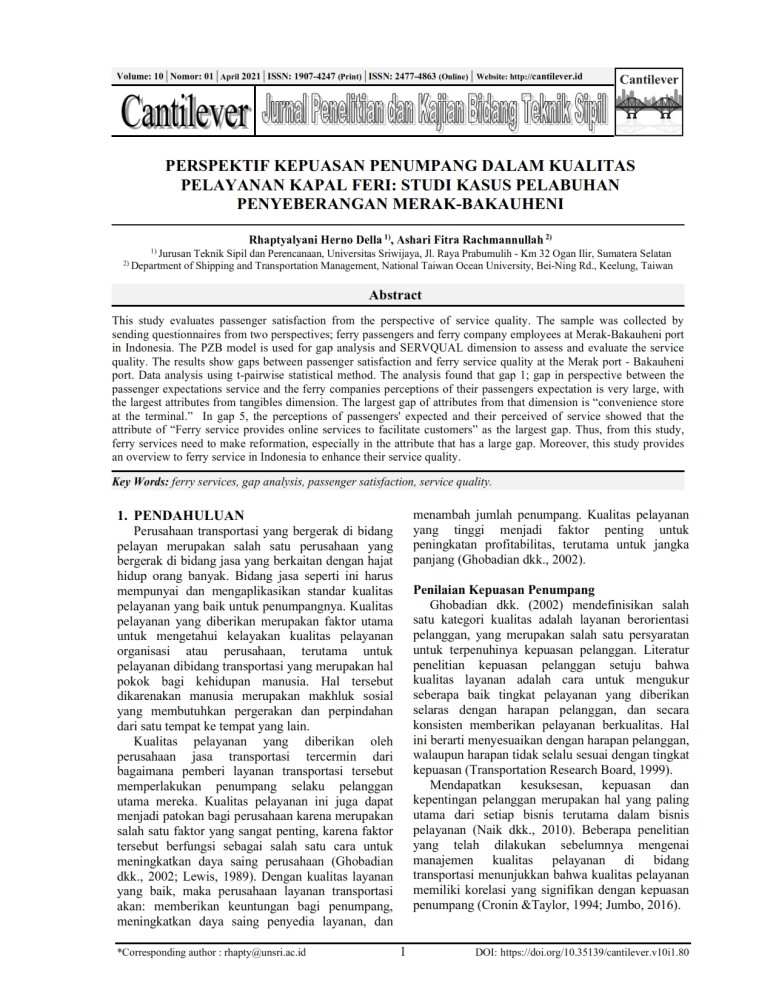Perspektif Kepuasan Penumpang Dalam Kualitas Pelayanan Kapal Feri: Studi Kasus Pelabuhan Penyeberangan Merak-Bakauheni Passenger Satisfaction Perspective on Ferry Service Quality: A Case Study of Merak-Bakauheni Ferry Port
Main Article Content
Abstract
This study evaluates passenger satisfaction from the perspective of service quality. The sample was collected by sending questionnaires from two perspectives; ferry passengers and ferry company employees at Merak-Bakauheni port in Indonesia. The PZB model is used for gap analysis and SERVQUAL dimension to assess and evaluate the service quality. The results show gaps between passenger satisfaction and ferry service quality at the Merak port - Bakauheni port. Data analysis using t-pairwise statistical method. The analysis found that gap 1; gap in perspective between the passenger expectations service and the ferry companies perceptions of their passengers expectation is very large, with the largest attributes from tangibles dimension. The largest gap of attributes from that dimension is “convenience store at the terminal.” In gap 5, the perceptions of passengers' expected and their perceived of service showed that the attribute of “Ferry service provides online services to facilitate customers” as the largest gap. Thus, from this study, ferry services need to make reformation, especially in the attribute that has a large gap. Moreover, this study provides an overview to ferry service in Indonesia to enhance their service quality.
Downloads
Article Details
Bonaventura, A. (2015). Assessment of customers’ satisfaction from large buses services in urban public transportation a case of ubungo bus terminal. Mzumbe University.
Brida, J. G., Moreno-Izquierdo, L., &Zapata-Aguirre, S. (2016). Customer perception of service quality: The role of Information and Communication Technologies (ICTs) at airport functional areas. Tourism Management Perspectives, 20, 209–216.
Ceder, A. (2006). Planning and evaluation of passenger ferry service in Hong Kong. Transportation, 33, 133–152.
Cronin, J. J., &Taylor, S. a. (1994). SERVPERF versus SERVQUAL : and Reconciling of Service Measurement Perceptions Quality. Journal of Marketing, 58, 125–131.
Febrina, Y. A., &Oetomo, H. W. (2016). Pengaruh Fasilitas, Kualitas Layanan Dan Lokasi Terhadap Kepuasan Penumpang Pt. Asdp. Ilmu dan Riset Manajemen, 5, 19.
Ghobadian, A., Speller, S., &Jones, M. (2002). Concepts and Models. Downloaded by Universiti Teknologi MARA At 08:39 15 June 2016 (PT) International Journal of Quality & Reliability Management, 11, 43–66.
Isa, M., Lubis, H. A., &Chaniago, M. (2019). Pengaruh Kualitas Pelayanan Terhadap Kepuasan Penumpang Menggunakan Jasa Angkutan Penyeberangan PT. ASDP Indonesia Ferry (Persero) Cabang Sibolga. Jurnal Ekonomi & Ekonomi Syariah, 2, 164–181.
Jumbo, J. (2016). Customer satisfaction and service quality : the case of the Road Transport Authority ( RTA ) of Dubai , in the United Arab Emirates Customer satisfaction and service quality : the case of the Road Transport Authority ( RTA ) of Dubai , in the United Arab.
Kelley, S. W., &Turley, L. W. (2001). Consumer perceptions of service quality attributes at sporting events. Journal of Business Research, 54, 161–166.
Kim, Y. K., &Lee, H. R. (2011). Customer satisfaction using low cost carriers. Tourism Management, 32, 235–243.
Laming, C., &Mason, K. (2014). Customer experience - An analysis of the concept and its performance in airline brands. Research in Transportation Business and Management, 10, 15–25.
Leong, L. Y., Hew, T. S., Lee, V. H., &Ooi, K. B. (2015). An SEM-artificial-neural-network analysis of the relationships between SERVPERF, customer satisfaction and loyalty among low-cost and full-service airline. Expert Systems with Applications, 42, 6620–6634.
Lewis, B. R. (1989). Quality in the Service Sector: A Review. International Journal of Bank Marketing, 7, 4–12.
Naik, C. N. K., Gantasala, S. B., &Prabhakar, G.V. (2010). Service Quality (Servqual) and its Effect on Customer Satisfaction in Retailing. European Journal of Social Sciences, 16, 231–243. Diambil dari http://lms.ctu.edu.vn/dokeos/courses/KT321/document/LUOC_KHAO_TAI_LIEU/chat_luong_dich_vu_va_su_hai_long_cua_dv_ban_le.pdf
Parasuraman, A., Berry, L. L., &Zeithaml, V. A. (1991). Refinement and Reassessment of the SERVQUAL Scale. Journal of Retailing, 67, 420.
Parasuraman, A., Zeithaml, V. A., &Berry, L. L. (1985). A Conceptual Model of Service Quality and Its Implications for Future Research. American Marketing Association, 49, 41–50.
Parasuraman, A., Zeithaml, V. A., &Berry, L. L. (1988). Servqual: A Multiple-Item Scale For Measuring Consumer Perc. Journal of Retailing, 64, 12.
Parasuraman, A., Zeithaml, V. A., &Berry, L. L. (1994). Reassessment of Expectations as a comparison Standard in Measuring Comparison Service for Quality: Implications Further Research. Journal of Management, 58, 111–124.
PT. ASDP Indonesia Ferry (Persero). (2020). Laporan Tahunan 2019. Jakarta. Diambil dari https://www.indonesiaferry.co.id/assets/images/laporantahunan/ASDP-AR2019-LowRes.pdf
Suki, N. M. (2014). Passenger satisfaction with airline service quality in Malaysia: A structural equation modeling approach. Research in Transportation Business and Management, 10, 26–32.
Suwandi. (2010). Analisis Pengaruh Kepuasan Pelanggan Terhadap Pelayanan Jasa. Sosialita, 1.
Tinali, G. Z. P., &Temba, G. M. (2015). Ferry passengers’ satisfaction: An empirical assessment of influence of ferry route type. ORSEA Journal, 5, 118–151.
Transportation Research Board. (1999). A Handbook for Measuring Customer Satisfaction and Service Quality. Transit Cooperative Research Program, Report 47. Washington, D.C.: National Academy Press.

This work is licensed under a Creative Commons Attribution-NonCommercial 4.0 International License.
Authors who publish with this journal agree to the following terms:
- Authors retain copyright and grant the journal right of first publication with the work simultaneously licensed under a Creative Commons Attribution-NonCommercial 4.0 International License that allows others to share the work with an acknowledgment of the work's authorship and initial publication in this journal.
- Authors are able to enter into separate, additional contractual arrangements for the non-exclusive distribution of the journal's published version of the work (e.g., post it to an institutional repository or publish it in a book), with an acknowledgment of its initial publication in this journal.
- Authors are permitted and encouraged to post their work online (e.g., in institutional repositories or on their website) prior to and during the submission process, as it can lead to productive exchanges, as well as earlier and greater citation of published work (See The Effect of Open Access).
